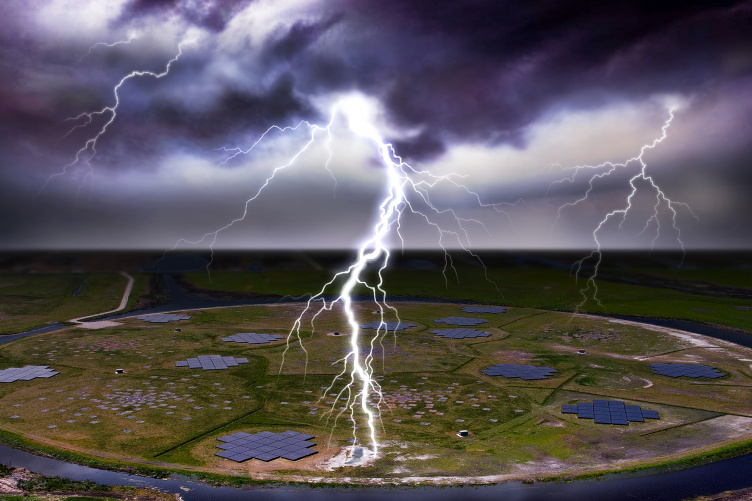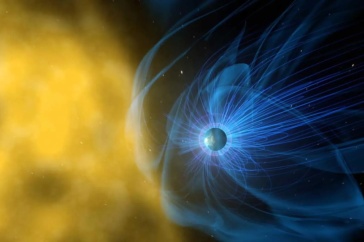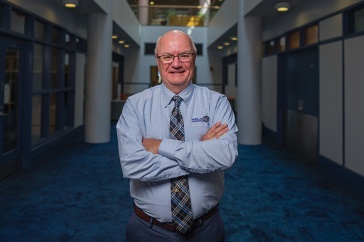
Lightning strikes in The Netherlands near a low-frequency array (LOFAR) of antennas that recorded new details about lightning formation. Illustration by Danielle Futselaar.
In what scientists are calling a significant step forward in lightning research, new 3D data images have revealed the cause for unusual electrical activity in storm clouds.
When a lightning charge is just beginning in the clouds, a hot channel (called a leader) carrying an electrical current and spreads out in two directions — with one end that has a positive charge and the other end that has a negative charge. Often, the positive end appears to disconnect from the rest of the channel, and scientists have now discovered a reason why this might happen: The positive leader forms numerous tiny side channels where the electrical current moves into and then stops like a dead-end street.

The formation is similar to a pine tree branch, where the charge would end at the needles without anywhere else to go, explains Joe Dwyer, a physics professor at the University of New Hampshire’s Space Science Center. The research, published in Nature, was led by researchers in The Netherlands and Belgium. Dwyer helped to interpret the data and is a co-author on the study.
“We’re not sure why one end of the leader does that, but it’s pretty weird,” he says. “It’s also an interesting clue to help us figure out how lightning propagates,” he says.
In the field of lightning physics, there are some big questions that haven’t yet been answered —like how lightning starts, moves, or strikes. “You can come up with all the greatest computer models in the world but if there’s not a solid observation it’s hard to make progress and definitively answer those questions,” Dwyer says. “These improved observations offer a substantially better view of what’s going on and can help guide us when we’re trying to develop models to describe lightning.”
The 3D images for this research were compiled from radio waves emitted from the lightning activity inside the clouds. A large array of antennas — more than a thousand spread out over The Netherlands and other parts of Europe — then picked up the radio waves to provide a highly detailed set of data that describe the shape of the leader. This array, called LOFAR (short for “low frequency array”), was originally developed for astrophysics research but has quickly gained popularity from lightning researchers. It’s a type of interferometer, an instrument that provides an incredibly fast and intricate view of what’s happening in the clouds before a lightning strike even emerges. Interferometers are reshaping the research landscape for scientists like Dwyer and his colleagues at UNH and beyond.
“Suddenly we’re clearly seeing these lightning leaders and they look very different than we thought they would.”
Dwyer says this advancement in imaging technology is akin to having poor vision your whole life and finally putting on a pair of glasses with the correct prescription — it makes that much of a difference.
“A lot of scientific advances happen when you get a new view of something due to an improvement in technology,” he explains. “Suddenly we’re clearly seeing these lightning leaders and they look very different than we thought they would.”
For more information about lightning safety, please visit https://www.eos.unh.edu/space-science-center/research/lightning-physics.
The Institute for the Study of Earth, Oceans, and Space (EOS) is UNH’s largest research enterprise, comprising five centers with a focus on interdisciplinary, high-impact research on Earth and climate systems, space science, the marine environment and seafloor mapping. With more than $43 million in external funding secured annually, EOS fosters an intellectual and scientific environment that advances visionary scholarship and leadership in world-class research and graduate education.
-
Written By:
Rebecca Irelan | Institute for the Study of Earth, Oceans, and Space | rebecca.irelan@unh.edu | 603-862-0990

















































